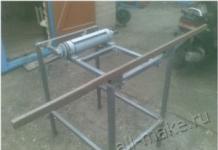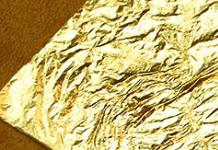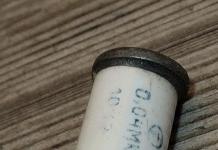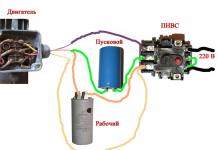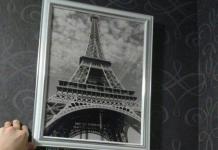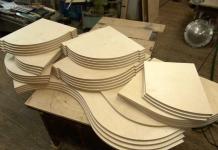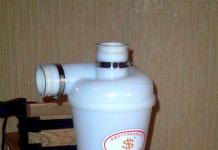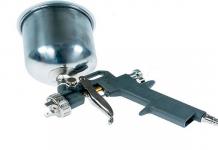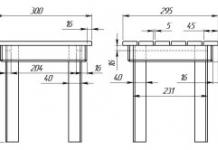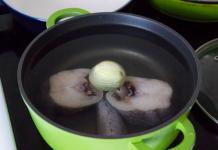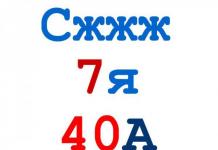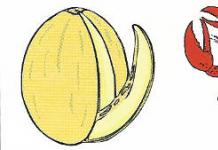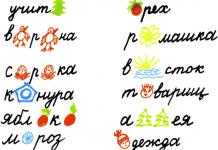Gilding is the process of applying a thin layer of gold or its imitation to an object. There are two types of gilding - gold leaf and potal.
GOLD LEAF AND POTAL - WHAT IS THE DIFFERENCE?

GOLD LEAF
Gold leaf- natural gold in the form of the thinnest sheets, which are stacked in books. Classic 960 gold leaf, but there are also other varieties. Sheets of the 960th test have a warm yellow color of native gold, it is these gold sheets that began to be used in Ancient Russia. The rules for the production of 960 gold leaf are enshrined in GOST 6902-75.
Gold leaf is suitable for use on almost any surface (wood, glass, ceramics, marble, porcelain, metal, plaster, canvas, paint layer, etc.), and is the only suitable material for gilding large objects such as domes, statues, etc. .P. Gold leaf can be used for gilding objects inside and outside the premises, it does not oxidize and does not darken.
POTAL
Applies to interior work only. Recommended for water-repellent surfaces (glass, metal, plastic, etc.) and vertical surfaces. The adhesive is applied with a flat brush on the prepared surface, reaches technological stickiness after 30 minutes and remains usable for 3 hours.
Diluted with alcohol thinner.
For professionals
These tools are usually used when working with gold leaf.
Professional mordan, it is applied both to internal, and to external works. Suitable for all types of surfaces. The adhesive is applied with a flat brush to the prepared surface. The time after which it reaches technological stickiness depends on its type: slow-drying - 12 hours, quick-drying - 1.5 hours. Slow-drying mordan remains usable for 24 hours, quick-drying - for 1.5 hours.
Diluted with white spirit.Rabbit (rabbit) glue
For special techniques and restoration work. Glue of animal origin, available in granules for easy storage. It is used to create an adhesive base for sheets of gold leaf or gilding. To prepare the glue, it is necessary to dilute the glue in a water bath (100 g of granular glue per 1 liter of water) and filter it with a fine mesh. You can start gilding a few hours after applying the glue.
Fish glue (gelatin)Gelatin is usually sold in the form of flakes, which must be soaked in water for about 24 hours before use. After softening, it is necessary to finally dissolve the glue in a water bath. Unlike other adhesives, when diluted with water, it slightly increases in volume. Gelatin is used to stick the gold leaf onto the bolus.
Aging
Makes gold shine darker and duller. It is used to give products an aged look. After drying, after 12-24 hours, the bituminous varnish is fixed with shellac varnish.
Paste bitumen is a dense, viscous substance of dark brown color. It has the same properties as ordinary bitumen. Lays down practically on any surface. Dries out in 12-24 hours. Lacquering is recommended to prevent rubbing.
It is used to give an aged look to decorated objects, and in the technique of gilding. Applies to any kind of base. After drying, it requires fixing with a finishing varnish.
Finish coat
Varnish Mecca- protective lacquer, applied to gilded objects to protect them from aging and environmental influences. Available in two types: colorless and gold. The second varnish is used if you want to darken the tone of gold or give a golden hue to silver.
Varnish Tsapun(lacquer Tzapon) - nitrocellulose transparent varnish for protection of products covered with potal. Dries quickly, forms a transparent protective film on shiny metal surfaces, preventing discoloration and corrosion. Suitable for processing products made of silver, copper, brass, bronze, tin, iron.
Water-based varnishes can oxidize potal, therefore, if the use of such a varnish is required, at least three protective coats of alcohol-based varnish must first be applied.
Shellac (Pure gummilac)
After drying, shellac forms a strong, abrasion-resistant, vitreous film. Interferes with formation of cracks and protects a leaf from mechanical and atmospheric influence. Ideal for gilded pieces of furniture that are in frequent use.
Shellac is available both in the form of flakes, from which you can make your own varnish, and in the form of a ready-to-use varnish.
Instruments
Brush for transferring the gold leaf/solid onto the gilder pad or surface. The brushes are made from oxhair or squirrel and range in size from #35 to #85 and larger. Thanks to the use of lampenzel, the thinnest sheets of gold/gold do not crumple or tear during transfer.
Gilding- a very ancient technique of decorative finishing. It has been used since prehistoric times. Indeed, native gold is one of the first metals known to man. And then, in the Bronze and Iron Ages, nothing could compare with the noble metal in terms of color intensity, depth of tone, and softness of luster. And the master who made the blade considered it his duty to decorate it with a gold pattern. Otherwise, the work lacked the finishing touch.
Kievan Rus has been famous for its goldsmiths since time immemorial. However, they did go down in history. The annals mention that the Grand Duke Vladimir ordered to decorate the silver head of Perun with a golden mustache. And it was even before the baptism of Russia!
In the 9th-10th centuries, gold began to be used on a larger scale; they were decorated with details of architectural structures. So, in 1113, at the behest of Prince Svyatopolk, the grandson of Yaroslav the Wise, the domes of St. Michael's Cathedral were gilded in Kyiv, and since then it has become known as Golden-domed. Another interesting monument has been preserved, confirming the art of the ancient masters - the copper doors of the cathedral in Suzdal with a gold pattern on a black lacquer background. In those days, heating during gilding was carried out on coals, and the metal was pickled with cranberries. However, the gold plating did not age for centuries, despite being outdoors and being touched by thousands of hands!

The gold finish of the old candlestick made it elegant and solemn. It remains only to decorate it with red balls and light candles. The house is ready for Christmas Eve.
Decorative gilding
Precious metals have been used at all times in the decoration and decoration of the interiors of palaces, creating the impression of unthinkable wealth and luxury. But there is an opportunity to make a small object sparkling and without large financial costs.
Gilding is a creative process. Two wooden candlesticks show us how the transformation takes place. It is easy to transform and native walls. The basis will be a smooth surface, for example, vinyl wallpaper. We apply paint on the wall using a template, lightly touching it with a brush dipped in gold paint. Gold and silver color will easily give a noble look to the most ordinary things: candlesticks, paintings, caskets.

Preparing for decorative gilding
Gilding is a very complex and lengthy process that requires patience, accuracy and experience. To gain this experience, it is worth starting with simpler decorating methods that imitate gold coatings. Our goal is to give products a beautiful, noble, sparkling look. And it is natural that the golden surface should have an impeccable appearance. The slightest flaws: traces of processing, scratches, roughness, even dust particles - and the work is ruined! Therefore, the surface of a wooden object is polished, cracks are sealed, dust is carefully removed.

Using liquid gold paint, you can apply a geometric or floral ornament to the wall. Contrasting transitions between the red matte color of the wall and the gold pattern, sparkling metal, create the effect of truly royal wealth.
There are ready-made gold paints, when applied to a cleaned surface, a golden look of the product is obtained. The paint consists of a metal powder that reproduces the color of the metal (gold, bronze, copper, iron, etc.). However, paint can only approximate real leaf cover.
|
1. Acrylic paint is applied as a primer to a prepared wooden candlestick. Red is best suited to gold, and cool blue to silver. Let the soil dry. |
2. Before applying, the gold paint is thoroughly mixed with a wooden stick, as the pigments settle to the bottom of the container. A small amount of gold paint is poured into an old saucer and the candlestick is evenly tinted from the bottom up. The paint dries very quickly. |
3. To give the candlestick an antique look, after the paint has dried, the “golden” layer is lightly sanded with coarse wool until the red primer layer begins to show through in some places. |
In a gold frame - gold leaf
Since ancient times, gilding was carried out mainly in two ways: by sticking gold leaf on the subject of leaves of gold foil or by fire gilding based on the use of mercury. The second method of gilding is very dangerous. For example, when the domes of St. Isaac's Cathedral in St. Petersburg (1838-1841) were gilded, about 60 people were poisoned by mercury vapor. Now this method of gilding is not used.
But gilding with gold leaf is widely used today. The word "leaf" comes from the ancient word "leaf" - a face, that is, leaf - facing. Such gold is stored in special books, in which 60 sheets of gold with a thickness of 0.13 to 0.67 microns are placed between sheets of paper. Sheet size - 80 x 80, 72 x 20 mm. There may be other sizes.
Gold leaf can be free and transfer. Free gold is just a very thin layer of the metal. You can’t touch it with your hands, it is blown away by breathing, so the gilder manipulates it (transfers, cuts, smoothes) with the help of a special knife and a squirrel brush. In general, considerable skill is required. In transfer gold, each of its sheets is placed on white silk paper, together with which it is transferred to the surface to be coated. When the gold is stuck in place, the silk paper can be removed. Transfer gold is much easier to work with.
|
1. The prepared surface of the frame is painted with acrylic paint. After drying, the surface is carefully sanded, dust is removed and a second layer of primer is applied. It is being polished again. If necessary, the operation is repeated again. |
2. Then, dry and dust-free, the base is painted with oil varnish with a brush. Gold leaf or its substitute is glued to the varnish. After about three hours, the varnish dries up, acquiring an ideal adhesive ability. If you run your finger over it, a slight whistling sound is heard. |
|
3. It's time for the most important operation - we begin to cover the surface with gold. We put a sheet of transfer gold on the prepared frame and press it lightly (the paper side is on top). |
4. The paper is removed, and the gold leaf is gently pressed with a cotton swab. It is advisable not to rub, but to tap lightly so as not to damage the thinnest layer of gold. Gilders use squirrel, kolinsky and rubber brushes to transfer and smooth gold. |
|
The frame is gilded by gold leaf |
|
There are two types of gilding with gold leaf: oil (matte) and adhesive (glossy).
Oil gilding can be used on almost any surface - wood, metal, plaster, plastic. This is a fairly simple, convenient and common method of gilding. This method is called oil because the gold leaf is glued on oil varnish - mordan. The composition of the lacquer can be different, it all depends on the conditions in which the gilded object will be.
Glue gilding used only for interior work. In this way, wood is mainly gilded, sometimes plastics (polyurethane). The technique of water gilding has remained virtually unchanged since ancient times.
Gold leaf and various types of gold paints can be purchased at art stores. In the assortment you have transfer gold of different sizes and shades: white gold, yellow gold, pure gold of 24 carats. It must be remembered: the purer the gold (the more carats it contains), the less sensitive the gilding will be to the influence of weather and climatic conditions. A material that anyone can purchase to try their hand at gilding is transfer gold foil.

Not all that glitters is gold
A gilded product is an expensive thing, not accessible to everyone. Basically, the price is high because of the high cost of gold. Therefore, gold leaf found a cheaper replacement. One of the famous substitutes for gold leaf is potal. Potal does not contain precious metals and is the thinnest sheets of a metal alloy - copper with zinc or copper with aluminum. Potal is much cheaper than gold leaf. And it is great for expressing individuality and even a momentary mood. The technique of decorating with potal is similar to decorating with gold leaf.
Film gilding
With some stretch, gold self-adhesive film for laser printers, from which stickers and stickers on CDs are made, can also be attributed to the ceilings. This material is quite accessible to home craftsmen, and it is easy to work with it. The film is unwound from the roll and gradually sticks to the surface. Film gilding is used only on flat surfaces. So they gild, for example, simple ones. It is customary to cover all imitators of gold, as well as gold leaf with impurities, with a protective layer of varnish.
|
1. To turn a wooden box into a gold one, we will use potal. First you need to apply glue to the base. In this case, acrylic is suitable (it dries quickly). |
2. The sheet of potali is glued in its entirety Since it is thicker than gold leaf, it can be separated by hand and placed on dried dry glue. The sheets should lie without wrinkles, one on top of the other with a slight overlap. |
|
3. With the help of a kolinsky brush, the sheeting is smoothed and glued to the base with a light tap. Especially carefully you need to press the edges and corners. The excess is picked up on a piece of paper for later use. |
4. Since the leaf is made of metals such as copper, zinc and aluminum, it oxidizes and darkens when exposed to moisture. Therefore, a protective layer of transparent varnish must be applied on top. Use shellac or zaponlac. Bituminous varnish gives gilded things an antique look. After drying, the varnish is polished everywhere, except for hard-to-reach places where a noble patina remains. |
Metal in the interior today is especially relevant. Even small accessories like caskets, cornices, candlesticks, if you give them a shiny look, completely change the impression of the apartment. The easiest way to transform them is with metallic glitter or metallic paint in an aerosol can. Working with these materials is interesting, easy and pleasant.

As if by magic, you can literally prepare for Christmas in half an hour. Household items such as nuts, pebbles, and curly gourds actually have a wider range of uses than is commonly believed. Especially if the surface, sparkling with gold and silver, is illuminated with candles.

A layer of glue is applied to the box with a brush and, while it is still wet, sprinkled with small sparkles. Spangles are distributed by hand, making sure that the surface is covered evenly. Wonderful dressing table decoration.
Aerosol paints imitating metal are now commonly available. They can be applied to any surface: paper, wood, metal, plastic, glass, even on the wall. You can buy aerosol "gold" in car dealerships. With its help, you can not only create golden caps on the wheels of a car, but also ennoble nondescript interior items. A table lamp, old picture frames, blackened cornices from time to time - there are a lot of points of application! To obtain a brilliant result, it is important that the surface is dry, thoroughly cleaned of dust and rust. Processing must be done twice. Both coats will dry within an hour. Unfortunately, it is technically impossible to keep the shine for a long time. But don't be upset: when the glitter fades, just apply a new layer of aerosol with gold.
On the eve of the New Year's carnival, we will give another idea to parents: your daughter will surely like that her quite ordinary shoes suddenly turned into golden ballroom shoes. Just don't forget to degrease them before painting!

Another idea for the holidays
With the help of glue on a sheet of gift paper, draw a contour and leave it to dry until the glue becomes transparent. Then put gold or silver transfer foil on top and gently rub in. After that, carefully remove the base paper. Such a pattern can even be made on textiles - a T-shirt or a baseball cap. A great gift for the New Year - both unique and practical!
In art stores, you can find gold paint in the form of a paste. Pastes are usually made from beeswax and metallic pigments. The paste is ideal for restoring an old frame or an old wooden candlestick. It is applied with a finger and carefully rubbed into the surface. To get the effect of antiquity, the gold trim of the frame can be slightly “aged” by rubbing a little natural umber into the curly profile.

This is the complexity of working with the material itself. After all, even the lightest draft can lead to the loss of more than one hundred dollars if a weightless and expensive golden leaf falls under its influence. Also, gold leaf cannot be taken simply with your hands - its weightlessness and fragile structure will instantly affect. He will turn to dust in the hands of the unfortunate master. Therefore, they work with it with a special tool and having at least simple skills in handling such a delicate and expensive material.
Imitation gold
Substitutes are designed to somewhat reduce the cost of decorating for precious metal. It can be either gold on silver - a double, or gold on a copper base - talma. The high cost of the metal itself also contributed to the origin of such imitators of a gilded surface, such as an alloy of potal - silver with aluminum, as well as tin disulfide, most often used in gilding wood and gypsum.
Ministry of Education and Science of the Russian Federation
State educational institution of higher professional education
"St. Petersburg State University of Technology and Design"
Institute of Design and Arts
Department of Interior Design
"Scope of gold leaf"
Performed:
Group 1 student MG11
St. Petersburg
1. Introduction
3. History of gilding
4. Characteristics of gold leaf
5. Gilding technique
6. Imitation gold leaf
7. Conclusion
1. Introduction
Previously considered a standard of good taste and an indicator of wealth, gold leaf is now of interest to people of various creative professions.
The noble radiance of gold leaf today is once again becoming extremely popular, because the scope of this material is limited only by designer imagination. More and more craftsmen are discovering gold leaf and making their creations shine with noble reflections!
2. Application of gold leaf
gold leaf gilding
With gold leaf, you can decorate not only small things like caskets and ashtrays, but also large-scale structures, such as domes, facade decoration, sculptures, statues, etc. Stucco molding using gold leaf has long been in vogue - mirrors, vases, picture frames ...
And of course, icons are perhaps the most popular area for using gold leaf. For this, gold foil is taken with a low percentage of ligature - as a rule, pure 999 gold. But for exterior decoration, you can take low-grade gold.
Gold leaf is used even in cooking. The fact is that pure gold is biologically inert and so soft that it does not form dangerous cutting edges, which is why it is widely used to decorate various dishes. As a food additive, gold leaf was even assigned the code - E175. Most often, sweets are covered with gold, it is added to alcoholic beverages (in particular, vodka with golden flakes), and in Japan there is even such an exotic product as 'gilded' coffee.
Gold leaf is also used in textile production, because now technologies have been developed that allow applying gold not only to metal, but to any surface. Designers have already appreciated the advantage of this material and add golden details to their work. Stylists are also not far behind - gold leaf is applied to the skin, nails, hair, making them shine and shimmer with a noble brilliance.
2. History of gilding
The roots of the tradition of gilding go back to pre-Columbian America. Even then, gold attracted increased interest, its properties and possibilities of application were studied. The origin of the name gold leaf remains a mystery, but the word `susalo` is considered the most realistic version - in the Old Russian language it meant `face, muzzle`. That is, the front part of the products was covered with gold leaf.
One of the first properties discovered in gold was its malleability. With appropriate processing, a piece of gold ore could turn into the thinnest cloth or thread.
It was then that for the first time the idea appeared to clothe various objects in gold linen, giving birth to the art of sheet gilding, which is still used today.
For the first time, gold leaf appeared in India, then from there it came to the Middle East, to Egypt, where it was actively used to decorate the tombs of the pharaohs. Gold became a sign of power; the pharaohs' wooden stretchers were decorated with it to emphasize their high position.
In the X-XI centuries, the art of gilding became widespread in the territory of Kievan Rus. If we believe the acts preserved from the State Archives, then in 1722 in Moscow, at the Varvarsky Gate, a whole factory of “drawn and flattened” gold functioned.
With the help of sheet gilding, the spire of the Admiralty in St. Petersburg is decorated today, the Samson fountain is covered in Petrodvorets, and the list is not limited to this.
Over time, it was found that gold dissolves perfectly in mercury, then they began to make amalgam and "mercury gold", which is a special method of applying amalgam to a previously prepared surface, as a result of which mercury evaporates, and a thin golden film remains on the surface. This method is characterized by high durability of the coating, it can last about 100-150 years.
In ancient Russia, the amalgam method was widely used. The copper surface of an object or just a copper sheet was heated, after which varnish was applied to them. On the resulting lacquer surface, a pattern was scraped off, after which the surface was rubbed with amalgam and heated. Then the lacquer was removed, leaving a gold pattern on a black or brown background.
St. Isaac's Cathedral in St. Petersburg is decorated in a similar way.
The main disadvantage of this method of gilding is its danger to people, since only 60 people were poisoned by mercury vapor during the work on decorating the same St. Isaac's Cathedral. Therefore, today this method is no longer used, it has been replaced by safer types of gilding.
For gilding, the property of gold to decompose when combined with various substances and heated is also used. In particular, in ancient times, gilders applied gold to glass and porcelain items, after which they calcined them in furnaces. As a result of such an operation, a beautiful golden pattern appeared on the surface.
3. Characteristics of gold leaf
Gold leaf is stored in booklets, between the sheets of which are stacked 60 leaves of gold of various sizes (72x120 mm, 91.5x91.5 mm, 8x8 cm, etc. sizes). The thickness of gold sheets varies from 0.13 to 0.67 microns. The weight of the book (ligature weight), depending on the thickness of the sheets, also ranges from 1.25 to 6 g. Books weighing more than 2.5 g are used for finishing only external (outer) surfaces, thinner sheets are used for gilding products and interior decor.
4. Gilding technique
Working with gold leaf requires considerable skill, because the sheets are so thin that they cannot be taken with your fingers - there is a risk of breaks and damage. The leaves are removed from the booklet, having previously cut it, with tweezers or a special gilding brush, and placed on the prepared surface. To fix gold, pentaphthalic varnish is used, after which the glued sheets are lightly tapped with a swab dipped in water. After 2-3 days, excess gold and varnish are removed. To cover 50 square centimeters with gold leaf, you will need at least 60 sheets from a book.
According to the method of application, gold leaf can be free and transfer.
In the case of free gold leaf, the sheet is removed with a gilder's knife, and a figure of the desired shape and size is cut out on the pillow. Next, the sheet is transferred with lampemzel to the treated surface. Working with loose gold leaf requires some skill.
If the sheets are transfer, then this means that each sheet is placed by pressure on white silk paper. Then the sheet is taken out and transferred along with the paper, and after the gold sticks, the silk paper can be removed, that is, it is easier to work with such gold, and it is transferred like a sticker.
There is also gold leaf in rolls, it is also referred to as transfer gold, since it is produced on the basis.
Today, two methods of gilding with gold leaf are used: oil and glue. Let's consider each of them in more detail.
1. Oil gilding
This type involves lacquer-based gilding, as a result of which the surface becomes matte. Oil gilding is by far the most resistant to weathering, so it is successfully used for both indoor and outdoor work.
The popularity of this type of gilding is also so wide because it is one of the simplest methods of gilding, which is used on almost any surface from glass to metal.
The process of oil gilding is as follows: the surface of the part is carefully polished, then a special mixture is applied to it - gesso. After it dries, the surface is treated with oil varnish - Mordan. And only after that leaves of gold leaf are applied. Due to the use of oil varnish, the part cannot be sanded, which explains its matte surface.
2. Adhesive gilding
This type of gilding, unlike lacquer, gives a glossy surface, and is used only on wooden or polyurethane surfaces. Also known as polyment, water or water gilding. Water gilding is less resistant to weathering, therefore it is used exclusively for interior work.
Glue gilding technology has remained unchanged since ancient times. It is more labor intensive than oil gilding.
The surface of the part is first carefully ground, then primer is applied to it. After that, it is necessary to prepare a polymer - a bolus that is applied on top of the soil. Next, gesso is applied, and only after that you can apply gold leaf.
By the way, the glue method of gilding can also be used for outdoor work, but this requires a special unopolyment, which allows you to apply gold leaf in the same way as in the case of oil gilding, but the surface remains glossy. However, this technology is too complicated, so it is not recommended to use it on large areas. Basically, this method is used only to highlight certain details.
Those who are just learning the art of gilding often practice simplified gilding methods, for example, on mixtures. This method involves the use of ready-made special mixtures - mixions. The technology is extremely simple: mixions are applied to the base, and gold leaf itself is applied on top of them.
The chosen method of gilding affects the characteristics of the treated surface, in particular its brilliance and durability of the coating. In addition, this also affects the set of necessary materials.
The only thing that remains unchanged with any gilding method is the general scheme, which consists of 4 main stages, each of which uses materials and tools that correspond to the chosen method:
The surface is being prepared for subsequent gilding.
The general technique of gilding is carried out.
An appropriate primer is applied to the surface.
Application of gold leaf to the surface.
Surface preparation for gilding with gold leaf
Before starting work, the surface to be gilded is polished with glass sandpaper, all irregularities and roughness are removed (this type of processing is also called "cutting"), all cracks are filled with a special polishing paste.
Metal products are thoroughly cleaned of rust, dust, mortar and corrosion and painted several times with red lead in oil, or shellac, or standard automotive varnish. Sometimes golden ocher is applied as the last layer to give the gold a more saturated hue (but yellow crowns cannot be used for this purpose, otherwise the surface can darken very quickly).
The wood to be gilded must be dried, all knots and resinous places are removed, the joints are glued with gauze. Sometimes, for greater smoothness, the surface is completely glued with a canvas (thin cloth). Next, the surface is treated with hot glue (15 percent), which can penetrate deep into the pores of the wood.
If the surface is gypsum, it is cleaned of dirt, cleaned with medium-grain sandpaper, swept over with a dry brush and fixed with hot drying oil. Next, the surface is glued twice with a hot solution of sturgeon glue (the first time - with a weaker solution, 150 g of glue per liter of water; the second time - 200 g of glue per liter of water). Glue is diluted in water and dissolved in a water bath.
Before applying the primer, it is important to know: the more shiny the base, the more shiny the gilded surface will be. Therefore, the lacquer used (for oil gilding) should shine strongly.
When gilding on mixtures, the base is isolated with diluted acrylic paint, applied in several layers, and then the surface is polished.
If the surface is still not smooth enough, it is additionally stripped, that is, polished with horsetail or pumice.
Gold has long been considered the color of luxury and wealth. Gold in its decorative properties surpasses all other metals. It is also distinguished by high chemical resistance, it does not oxidize in air, in an environment of hydrogen sulfide and other gases. Unaffected by chlorine and bromine when heated to very high temperatures. This provides gold with a wide application both in the jewelry industry and in critical technical details. Ideally, of course, you can make a product entirely of gold, thus ensuring all the high performance of gold in the field of chemical resistance and invariability over time ... but! Gold is a soft and expensive metal... which means that if it is necessary to obtain a product with decorative and physical and chemical properties of gold, but not so expensive and much more durable, there is a need for galvanic gilding of more durable metals.
Technique and methods of applying gold to the surface:
- gold leaf (we apply a thin foil to any surface with glue);
— deposition of gold amalgam followed by annealing (old method);
- electrochemical gilding, i.e. coating under the action of an electric current;
— immersion gilding, deposition of gold without the application of external current.
In our company, we use only electrochemical and immersion gilding, because only these methods of application are safe enough and provide the proper quality of coatings*.
Electroplating with gold:
- pure yellow gold (without alloying additives, the purity of the coating will be 999.9);
- yellow gold with a small addition of cobalt as an alloying additive for greater hardness of the coating (the purity of the coating will be 999.0);
- red gold, or Russian gold. It has a hue from copper red to pale pink, you can get "Italian" rose gold (more yellow than in "Russian");
- green gold, an alloy of gold and silver (nickel).
- white gold (rhodium process).
The thickness of electroplated gold can be any, there is no upper limit on the thickness of gilding, the customer will decide for himself, based on the required thickness of gold and financial capabilities.
We will be glad to help you in the field of galvanic gilding of contact groups, bijouterie, jewelry and souvenirs.
Want to know more? Learn to make gilding with your own hands? Phone and e-mail of the technologist on the main page of the site.
Application of gold immersion coating:
Immersion gilding is used for details of complex shape. Electroplated gold, although it has a high scattering power, sometimes cannot provide a high-quality coating of the internal cavities of tubes or complex-shaped parts. In this case, it becomes necessary to use chemical gilding. The peculiarities of this process is the constant thickness of the coating at all points on the surface of the product. Sometimes the coating can only be done in this way, for example, when applying gold to the parts of a saxophone (the internal cavity of the pipes provides the “correct” sound). Often, immersion gilding is used in conjunction with electroplated gilding.
The cost of gilding in Moscow
Gold is gold, it has never been cheap, so the decision in favor of increasing the thickness of the gold coating will affect the cost of the work. I will try to show with an example: 0.2 microns of gold is called by experts as a coating “in color”, upon reaching this thickness, the color of gold no longer changes. That is, if you show someone, for example, two watch cases coated with 0.2 microns and 40 microns, respectively, then no specialist will be able to determine the thickness of the gilding by eye! Of course, if you put both cases under glass and never take them out, they will remain “twins” for many years, but as soon as you start wearing such watches, the owner of a watch with a 0.2 micron coating will very soon realize that he is wearing a cheap thing, and the owner of a watch with with a 40 micron coating will proudly give them to his son for his fiftieth birthday.
At our enterprise, you can get a service for applying gold plating of various thicknesses: for example, for technological parts, a coating in accordance with GOST 3-9 microns is most often used, depending on the requirements for the part. In some cases, the thickness of the gold coating should be 20-50 microns. In the vast majority of cases, for technical parts, the thickness of the gold coating is chosen to be 6 microns.
* It should be noted that there is another way to get a "golden" color on the surface of the product - sputtering of titanium nitride. In this case, we get a non-metallic non-conductive coating that has a golden color. The secret is that in fact the titanium nitride substance is not colored, and when applied with a thin film, the thickness of which is comparable to the yellow wavelength (565-590 nm), the eye sees the yellow color of the coating. They say that the product in this case is covered "under gold". All cheap souvenirs, fittings, sanitary ware are coated with titanium nitride, not gold.
Titanium nitride does not have the physical and chemical characteristics of gold. It does not have durability over time and invariance in color. An example of an old titanium nitride coating is the dome of the Cathedral of Christ the Savior in Moscow, and the domes of many churches throughout Russia. Over time, the beautiful golden color fades (under the influence of precipitation, fumes, mechanical damage), and turns into a red-brown and green hue. It is impossible to restore the color back! The only way out is to redo everything again by removing the old nitride. Thus, it becomes clear that titanium nitride coating, although similar in color to gold, has a limited service life and inadequate coating quality (even in the case of additional varnishing.
For us, the most undesirable quality of titanium nitride is the difficulty in cleaning the product from it. We are often brought for “restoration” a worn titanium nitride coating, often the customer himself believes that he is dealing with gold, the only way to do this work is to remove old materials, carry out all the preparatory operations for the gilding process (including mechanical processing of scratches and chips), and carry out gilding.
Our company provides services for applying gold to all surfaces and details. In each individual case, The final cost of the work is determined after the inspection of the part by the technologist and the approval of the customer's requirements.
The estimated cost of the work is shown in the table below:
| Name of service | Cost, rub |
|---|---|
| Gilding technical (more than 3 microns) | from 6 rub/sq.cm, 1 micron |
| Gilding decorative up to 3 microns | from 8 rub/sq.cm, 1 micron |
| Gilding "pink" under 585 sample | from 8 rub/sq.cm, 1 micron |
| Gilding "Italy" | from 6 rub/sq.cm, 1 micron |
| Gilding "white" (rhodium plating) | from 25 rub/gr product |
| Removing gold plating | negotiable |
| Restoration of gold plating | negotiable |
Examples of work on gilding products:
Yellow gilding of coins "Sochi 2014". gold thickness 0.5 microns.
The cost of covering one coin was 60 rubles, with a batch of 1000 pieces. No wear guarantee.

Yellow cobalt gilding token on a chain.
The cost of gilding the token on the chain was 5,000 rubles. Gold thickness 5 microns, abrasion warranty 2 years.
Glue gilding
This type of gilding, unlike varnish, gives a glossy surface, and is used only on wooden or polyurethane surfaces. Also known as polyment, water or water gilding. Water gilding is less resistant to weathering, therefore it is used exclusively for interior work.
Glue gilding technology has remained unchanged since ancient times. It is more labor intensive than oil gilding.
The surface of the part is first carefully ground, then primer is applied to it. After that, it is necessary to prepare a polymer - a bolus that is applied on top of the soil. Next, gesso is applied, and only after that you can apply gold leaf.
By the way, the glue method of gilding can also be used for outdoor work, but this requires a special unopolyment, which allows you to apply gold leaf in the same way as in the case of oil gilding, but the surface remains glossy. However, this technology is too complicated, so it is not recommended to use it on large areas. Basically, this method is used only to highlight certain details.
Those who are just learning the art of gilding often practice simplified gilding methods, for example, on mixtures. This method involves the use of ready-made special mixtures - mixions. The technology is extremely simple: mixions are applied to the base, and gold leaf itself is applied on top of them.
The chosen method of gilding affects the characteristics of the treated surface, in particular its brilliance and durability of the coating. In addition, this also affects the set of necessary materials.
The only thing that remains unchanged with any gilding method is the general scheme, which consists of 4 main stages, each of which uses materials and tools that correspond to the chosen method:
The surface is being prepared for subsequent gilding.
The general technique of gilding is carried out.
An appropriate primer is applied to the surface.
Application of gold leaf to the surface.
Surface preparation for gilding with gold leaf
Before starting work, the surface to be gilded is polished with glass sandpaper, all irregularities and roughness are removed (this type of processing is also called "cutting"), all cracks are filled with a special polishing paste.
Metal products are thoroughly cleaned of rust, dust, mortar and corrosion and painted several times with red lead in oil, or shellac, or standard automotive varnish. Sometimes golden ocher is applied as the last layer to give the gold a more saturated hue (but yellow crowns cannot be used for this purpose, otherwise the surface can darken very quickly).
The wood to be gilded must be dried, all knots and resinous places are removed, the joints are glued with gauze. Sometimes, for greater smoothness, the surface is completely glued with a canvas (thin cloth). Next, the surface is treated with hot glue (15 percent), which can penetrate deep into the pores of the wood.
If the surface is gypsum, it is cleaned of dirt, cleaned with medium-grain sandpaper, swept over with a dry brush and fixed with hot drying oil. Next, the surface is glued twice with a hot solution of sturgeon glue (the first time - with a weaker solution, 150 g of glue per liter of water; the second time - 200 g of glue per liter of water). Glue is diluted in water and dissolved in a water bath.
Before applying the primer, it is important to know: the more shiny the base, the more shiny the gilded surface will be. Therefore, the lacquer used (for oil gilding) should shine strongly.
When gilding on mixtures, the base is isolated with diluted acrylic paint, applied in several layers, and then the surface is polished.
If the surface is still not smooth enough, it is additionally stripped, that is, polished with horsetail or pumice.
Ground application
The soil is applied in several stages.
Sometimes layers of soil alternate with layers of glue to obtain a more even surface.
Stage 1. Applying the primer
After the glue applied at the first stage has dried, levkas (stone primer) is applied in a warm form - 2-3 times by the method of trimming the surface in order to impregnate the lower layer and ensure its better adhesion to the subsequent ones. A special bristle brush can be used for this. To keep the layer even, you can not often touch the same place. The wooden surface and structure must be visible. Then apply another 3-4 coats of white gesso primer, in the usual way, each time allowing the surface to dry completely. This second approach should hide any unevenness and create a sandable underlay, the wood surface should no longer show through.
In the third approach, the white primer is diluted with 5% alcohol, and the surface is covered with a wide hair brush, with the most uniform strokes.
Stage 2. Grinding
Further, after applying the gesso, the surface is polished again (smooth surfaces - with pumice, protruding parts - with horsetail, or micron sandpaper; you can still further sand with canvas with water and dry). Sanded places are glued with 7% animal glue. Grinding work must be carried out with extreme precision, since all indistinctly processed parts will be visible after gilding. Next, the surface is cleaned of grinding dust (with a vacuum cleaner or a damp cloth, or with a dry brush, or with a flute).
And only on this dried surface is the polymer applied, after diluting it with a 7% solution of animal glue (until the polymer begins to drain from the brush in a thick stream). Sometimes, for better adhesion, before applying the polymer, the surface is covered with a polymer adhesive diluted with 1/3 of water. The solution is heated to 35 degrees, and applied to a white primer.
Stage 3. Preparation for gilding
Experienced gilders apply gold sheets only a day after applying the primer. To do this, the surface is moistened with water (the sheets are applied immediately after the water acquires color), or with a 20% solution of ethyl alcohol using a soft hair brush (applied in small areas, on which gold leaves are immediately laid), or glue is applied (the recipe for this each master has his own glue).
Applying gold
To avoid touching the gold leaf, some gilders wear cotton gloves. There should be no draft in the room to make it easier to move the gold sheets. The thickness of the sheet is only a fraction of a micron, so the surface for coating is carefully prepared, and any speck of dust can tear the sheet.
A sheet of gold leaf or potali is taken out of the book with a light breath, helping him to wrap himself on a knife. With this knife, the sheet is transferred to the pillow, where it is smoothed and the desired shape is cut out with a knife.
The cut out figure can then be applied to the treated and primed surface coated with the selected adhesive. Gilding is carried out on a wet base, so only the space that can be gilded at one time is wetted. If dry spots appear, the surface must be moistened again.
The sheet is transferred to the surface with a special brush (lampemsel), after electrifying it, and then passing it over a hand lubricated with petroleum jelly; diligently and very carefully, the sheet is smoothed with a kolinsky brush, lightly tapping the brush hair or a cotton swab on the surface, and left to dry.
After the gold dries, the excess gold formed at the joints is collected in a paper bag (they may be needed later, during the post-processing of the product).


















